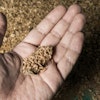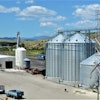
On May 23, 2013, the U.S. Department of Agriculture (USDA) Agricultural Marketing Service (AMS) issued a final rule on mandatory Country of Origin Labeling (COOL) requirements for muscle cut covered commodities. The rule requires origin designation labels to include information about where each of the production steps occurred, meaning the label must indicate where the animal was born, raised and slaughtered, even if each step occurred in separate countries. Since its release, strenuous objections have been issued by industry stakeholders and trading partners. This includes lawsuits and threats to impose retaliatory tariffs, respectively.
The COOL requirements originated in the 2002 Farm Bill. Final implementation was delayed for several years until the 2008 Farm Bill was enacted. That legislation included an agreement reached by interest groups most affected by the COOL provisions who had reached consensus on some of the more onerous provisions of the original law. The final measure amended the Agricultural Marketing Act of 1946 to require retailers to notify their customers of the origin of covered commodities. The list of covered commodities includes muscle cuts of beef, lamb, chicken, goat and pork; ground beef, ground lamb, ground chicken, ground goat and ground pork; wild and farm-raised fish and shellfish; perishable agricultural commodities, macadamia nuts; pecans, ginseng and peanuts.
AMS published a final rule implementing the COOL statute in January 2009. The rule adopted the following labeling system:
(A) “Product of the United States,” for meat derived from an animal born, raised, and slaughtered in the U.S., or present in the U.S. on or before July 15, 2008
(B) “Product of the United States, Country X, and (as applicable) Country Y,” for meat derived from an animal born and raised outside of the U.S. and imported into the U.S. more than two weeks before slaughter
(C) “Product of Country X and the United States,” for meat derived from an animal imported from Country X to be slaughtered within two weeks
(D) “Product of Country X,” for finished meat products derived from animals slaughtered outside the U.S. and imported from Country X
After AMS published this rule, Canada and Mexico filed a complaint before the World Trade Organization (WTO), contending that the requirements discriminated against Canadian and Mexican livestock imports and thus violated the WTO Agreement on Technical Barriers to Trade (TBT). In 2011, the WTO decided in favor of Mexico and Canada, specifically saying that COOL “creates an incentive to use domestic livestock—and a disincentive to handle imported livestock—by imposing higher segregation costs on imported livestock than on domestic livestock.” The WTO further noted that several U.S. processing plants discontinued the acceptance of imported livestock altogether. The decision was appealed by the Obama Administration, but was upheld in a 2012 ruling by the WTO Appellate Body, which required the U.S. to comply by May 23, 2013, the date on which the final rule was released and went into effect.
为了应对决策,AMS公布了国防部ified final rule on May 23, stating that “the Agency expects that these changes will improve the overall operation of the program and also bring the current mandatory COOL requirements into compliance with U.S. international trade obligations.” The final rule wasn’t all that different from the proposed rule which was issued previously, surprising many. The final rule requires the retail labeling of covered meat commodities to include the origin destination for each step of the production process; requires a modified label for those cuts exclusively processed in the U.S.; eliminates the use of mixed origin labels such as “Product of the United States, and Country X, and/or Country Y;” expands the definition of a retailer to be any entity that meets the retailer definition under the Perishable Agricultural Commodities Act of 1930; and precludes the use of special labels for commingled meat processed in the same day but in different countries.
Many industry groups felt that the revised rule’s requirements were even more discriminatory than the original, and decried the fact that the origin destination information for each step of the production process would still be required on a label. In response, in July of 2013, a collection of industry groups brought suit against the USDA, the AMS, Secretary of Agriculture Tom Vilsack and AMS Administrator Anne Alonzo, challenging the validity of the revised COOL Regulations and enjoining their enforcement. The groups originally joining the suit include the American Meat Institute (AMI), American Association of Meat Processors, Canadian Cattlemen’s Association, Canadian Pork Council, National Cattlemen’s Beef Association, National Pork Producer’s Counsel, North American Meat Association and the Southwest Meat Association. Since the initial filing, an organization comprised of Mexico’s 46 regional cattle unions, encompassing 2,000 local cattle associations and 800,000 cattle herds known as Confederacion Nacional De Organizaciones Ganaderas (National Confederation of Livestock Organizations, translated to English) has joined the suit.
Meanwhile, multiple consumer and industry groups have sought to intervene in the suit in favor of the revised rules. They include Food & Water Watch, Inc., Ranchers Cattlemen Action Legal Fund (R-CALF), United Stockgrowers of America, South Dakota Stockgrowers Association, Western Organization of Resource Councils, United States Cattlemen's Association, National Farmers Union, American Sheep Industry Association and the Consumer Federation of America. The Plaintiffs have filed a motion for a preliminary injunction, seeking to halt the implementation of the rule before it causes further damage to the industry. The motion was denied on Sept. 11, 2013. In denying the Plaintiffs’ motion for a preliminary injunction, the Court held that the Plaintiffs failed to demonstrate a likelihood of success on the merits or irreparable harm. The case will proceed as to the merits, but as of this writing no trial date has been established.
Pending the outcome of the court case, and even prior to the final rule’s publication, various policy fixes have been considered—both regulatory and legislative. Many assert that Congress must fix the law in order for the U.S. to comply with the WTO decision. This can be done a number of ways, but the Farm Bill and must-pass measures such as appropriations are obvious vehicles, given these have been the catalyst for COOL measures previously. The Farm Bill is currently being considered in the House and Senate, although neither bill contains substantive modifications to COOL. Nor have members indicated a desire to include in a continuing resolution (CR)—which is currently the route which Congress is likely to pursue—any sort of measure to fix COOL.
A regulatory fix is less-preferred by stakeholders, including those in Canada and Mexico. Such a change, however, would conceivably be made by USDA, again, or the U.S. Trade Representative (USTR). One previously proposed regulatory change includes allowing for more flexibility for commingling foreign and domestically processed cuts and using a multi-country label. This was opposed by COOL supporters for undermining the law’s intent.
Many prefer a legislative fix, difficult as it may be, to a regulatory fix. Some industry groups have suggested changing the law to allow for an alternative label which would say “Produced in North America.” Such a label could be used for any meat that underwent any portion of the production process in Canada, Mexico or the U.S. Or, the law could be changed such that any meat being processed in a U.S. meatpacking plant could use the label “Produced in the United States.” Either of these options would allow the industry to avoid the costs of separating, rather than commingling, meat cuts with different origins. Such changes have garnered the support of producer organizations in all three countries and are supported by consumer research saying either label is just as satisfactory.
Clearly, the ag-on-ag, ally-on-ally saga that is COOL carries on. We can only hope that the outcome, whatever that may be, allows for cost-effective production and processing, and unimpeded cross-border trade of such important agricultural commodities. Particularly between the United States, Canada and Mexico, such trade accounts for a significant amount of economic activity. In an increasingly global economy, such disputes and retaliatory actions can cause significant disruption to industry, and thus to economic progress, itself a notion to which each of the aforementioned countries appear to be committed.






















